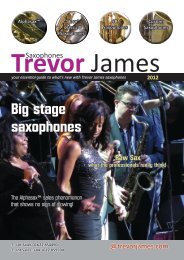SR saxophone review by Stephen Howard, author the
SR saxophone review by Stephen Howard, author the
SR saxophone review by Stephen Howard, author the
You also want an ePaper? Increase the reach of your titles
YUMPU automatically turns print PDFs into web optimized ePapers that Google loves.
ought without one. I find it very hard to resist saying "Told ya so!".<br />
Mind you, <strong>the</strong>re is one advantage that springs to mind ‐ if you ever need to have any dent or solder work<br />
done to <strong>the</strong> horn you won't have to worry about it affecting <strong>the</strong> finish, which will help maintain <strong>the</strong> horn's<br />
resale value over time.<br />
Simply polish off <strong>the</strong> marks, rub your hands over <strong>the</strong> area to start it tarnishing and in a few weeks no‐one<br />
will be able to tell <strong>the</strong>re was any work done.<br />
Fortunately <strong>the</strong> <strong>SR</strong> is also available in a lacquered finish, which is a ra<strong>the</strong>r more sensible option.<br />
As per <strong>the</strong> RAW, I would have liked to have seen larger guard feet fitted. It just helps to spread <strong>the</strong> load in<br />
<strong>the</strong> event of a knock, and may mean <strong>the</strong> difference between having to deal with just a dent and having to<br />
sort out a stoved‐in tone hole.<br />
I also noticed <strong>the</strong> relatively small size of <strong>the</strong> top F# key upper pillar base.<br />
This is ano<strong>the</strong>r vulnerable spot ‐ if <strong>the</strong> horn takes a tumble <strong>the</strong>re's nearly<br />
always some damage around this area, but what's more likely to happen is<br />
that <strong>the</strong> horn cops a whack just as you're getting up on stage and <strong>the</strong> pillar<br />
gets knocked off‐line. This will cause a leak at <strong>the</strong> top F# pad, and that's<br />
<strong>the</strong> horn out of action for <strong>the</strong> duration of <strong>the</strong> gig...and until you can get<br />
it<br />
repaired.<br />
It's <strong>the</strong> same on <strong>the</strong> RAW ‐ which is something I missed when I did <strong>the</strong><br />
<strong>review</strong>.<br />
Mind you, <strong>the</strong>re's a school of thought that says it's often better that a pillar<br />
gets knocked off in a fall ra<strong>the</strong>r than hanging on and creasing <strong>the</strong> body<br />
tube. Swings and roundabouts really, but I tend to favour <strong>the</strong> 'belt and<br />
braces' approach.<br />
The keywork is well‐constructed. Being pretty much <strong>the</strong> same as <strong>the</strong> RAW it's bound to be, though it lacks<br />
<strong>the</strong> double‐arm features of <strong>the</strong> flagship model. On <strong>the</strong> plus side though <strong>the</strong> pearls are proper Mo<strong>the</strong>r‐of‐<br />
pearl, which makes for a nice feel...and an extra nice touch is <strong>the</strong> perfectly placed and slightly domed BisBb<br />
key pearl against <strong>the</strong> slightly concave main stack pearls. This makes for a very comfortable transition from<br />
<strong>the</strong> B to <strong>the</strong> Bb.<br />
Ano<strong>the</strong>r nice feature is <strong>the</strong> use of Teflon sleeves on <strong>the</strong> octave key rocker<br />
arm. This helps to both quieten <strong>the</strong> mechanism and ensure it runs<br />
smoothly ‐ it also helps to prevent wear. When <strong>the</strong> sleeves wear out<br />
<strong>the</strong>y're easily replaced...none of that nasty metal‐on‐metal business that<br />
so many octave mechs make do with.<br />
The point screws are of <strong>the</strong> pseudo variety. At <strong>the</strong> time of <strong>review</strong> <strong>the</strong><br />
action was nice and tight ‐ but it won't stay that way forever, and <strong>the</strong>re's<br />
no provision for adjustment with <strong>the</strong>se screws. I'm told that TJ are still<br />
looking into using proper point screws (particularly on <strong>the</strong> RAW).<br />
There are adjusters fitted to both main stacks, which makes tweaking <strong>the</strong><br />
regulation much easier than having to muck about with bits of cork and<br />
sandpaper ‐ and, of course, <strong>the</strong>re are <strong>the</strong> usual adjusters for <strong>the</strong> G#,<br />
forked Bb and low C# ‐ as well as adjustable key arms on <strong>the</strong> G# and front<br />
top F.<br />
Topping off and powering <strong>the</strong> action is a set of blued steel springs.<br />
As <strong>the</strong> key layout is <strong>the</strong> same as <strong>the</strong> RAW I had no problems getting my<br />
fingers around it ‐ though I'm still finding <strong>the</strong> G# touchpiece just a mite<br />
too small for my tastes.



